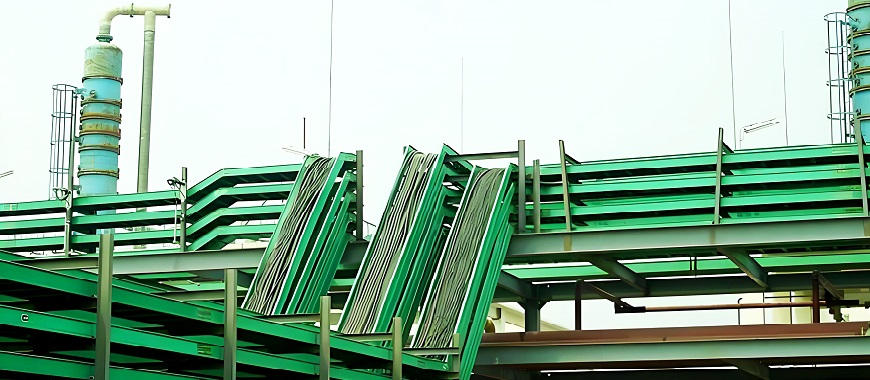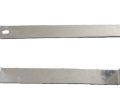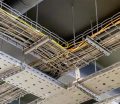
Cable tray junction boxes are essential components for managing and protecting electrical cables in various setups. These boxes serve as a secure enclosure for cable connections, ensuring safety and organization while fitting cable tray systems seamlessly. Commonly used in industrial, commercial, and residential environments, they help streamline wiring systems by preventing tangles and reducing maintenance challenges. Cable tray junction boxes are typically made from durable materials such as stainless steel, aluminum, or reinforced plastic. These materials ensure the boxes can withstand environmental stress, including high temperatures, moisture, and corrosion. Design options range from compact, wall-mounted styles to larger, versatile configurations for complex cable systems. With their ability to simplify cable management and enhance system reliability, cable tray junction boxes have become an indispensable solution in modern electrical infrastructure.
Key Features of Cable Tray Junction Boxes
Durability and Load Capacity in Industrial and Residential Setups
Cable tray junction boxes are designed to withstand demanding environments while maintaining their structural integrity. Their durability and load capacity make them ideal for managing electrical cables across various applications. Here are the key factors contributing to their reliability:
- Material Strength:
Cable tray junction boxes are often constructed from materials like stainless steel, aluminum, or reinforced plastics. These materials resist corrosion, high temperatures, and mechanical wear, making them suitable for both indoor and outdoor use. In industrial environments, they endure heavy loads and vibrations without compromising functionality. Residential setups benefit from their lightweight yet sturdy design, ensuring lasting performance. - Environmental Resistance:
These boxes are crafted to resist moisture, chemicals, and UV exposure. For example, in chemical plants, cable tray junction boxes must endure corrosive agents without degrading. Similarly, outdoor installations require UV-resistant coatings to prevent material breakdown under constant sunlight. - Load Capacity:
Industrial cable tray junction boxes can support multiple heavy cables without sagging. Engineers must assess the load-bearing capacity during installation to prevent overloading. Residential boxes, while handling fewer cables, also ensure safe and secure connections. - Safety Standards Compliance:
To ensure reliability, cable tray junction boxes meet stringent safety and performance standards. Proper grounding and insulation features protect against electrical hazards, providing peace of mind to users.
Compatibility with Various Cable Tray Systems
Cable tray junction boxes are engineered to integrate seamlessly with different cable tray systems, offering versatility and ease of use. Key compatibility features include:
- Standard Dimensions:
These junction boxes are available in sizes that fit common cable tray widths, ensuring easy integration. They align perfectly with cable tray dimensions ranging from narrow residential trays to wide industrial ones. - Adaptability:
Universal mounting systems allow cable tray junction boxes to adapt to various configurations, such as suspended ceilings, wall mounts, or floor setups. This flexibility ensures they can be customized for specific applications. - Ease of Modification:
Cable tray junction boxes can be modified to accommodate new wiring systems. Additional holes or conduits can be added without affecting the box’s integrity. This adaptability makes them an excellent long-term investment for growing electrical networks. - Interconnectivity:
Cable tray junction boxes often feature designs that align with other cable management components like trays, raceways, and conduits. This ensures a seamless transition between different systems, reducing complexity during installation.
Marine Cable Tray Systems for Optimal Cable Management
Cable Tray Junction Box Installation
Step-by-Step Guide for Installing Cable Tray Junction Boxes
Installing a cable tray junction box requires careful planning and execution to ensure safety and functionality. Follow this detailed step-by-step process:
Preparation
First, assess the cable layout and determine the optimal location for the cable tray junction box. Gather all necessary tools—such as a drill, screws, mounting brackets, and cable clamps—and verify that the junction box dimensions match the cable tray specifications to ensure a seamless fit and avoid any last-minute adjustments.
Mounting the Box
Secure the junction box to the cable tray using compatible mounting brackets or a cable tray box mount, making sure the box is level and properly aligned with the tray for a snug fit. Double-check the stability of the mounted box before proceeding to the next steps to prevent shifting or loosening over time.
Cable Management
Route the cables through the junction box openings, using cable clamps or ties to secure them firmly in place. Maintain appropriate spacing between cables within the box to avoid overcrowding and ensure each cable remains clearly accessible and identifiable.
Connection
Inside the junction box, connect the cables following all applicable electrical codes and guidelines. Use proper connectors and tighten every connection point to prevent loose wiring or electrical faults, ensuring a safe and reliable system.
Inspection
Conduct a thorough inspection of the entire installation: verify that all cables are securely attached, connections are intact, and there are no sharp bends or pinch points. Finally, test the system’s functionality before sealing the box to confirm that everything operates correctly.
Tools and Safety Considerations for Efficient Installation
- Essential Tools:
- Drill and screwdriver
- Cable cutters and strippers
- Cable ties and clamps
- Voltage tester
- Safety gloves and goggles
- Safety Considerations:
- Deactivate the power supply before handling any electrical components.
- Ensure the cable tray junction box is grounded to prevent electrical hazards.
- Use insulated tools to minimize the risk of electric shocks.
Can a Cable Tray Be Used as a Junction Box?
Explanation of Whether and How a Cable Tray Can Function as a Junction Box
A cable tray can sometimes function as a junction box under specific conditions, but this approach has limitations. Here’s an in-depth look:
- When It’s Possible:
- A cable tray may act as a makeshift junction box if enclosed sections are used to house cable connections.
- This setup works in low-voltage systems where minimal protection is required.
- When It’s Not Recommended:
- High-voltage systems require dedicated junction boxes to ensure safety and meet electrical standards.
- Open cable trays cannot provide adequate protection against environmental factors, such as moisture or dust.
Pros, Cons, and Scenarios Where This Setup Is Practical
- Pros:
- Cost-Effective:
Using a cable tray as a junction box can reduce installation costs by eliminating the need for separate enclosures.
For budget-constrained projects, this method may be considered, provided it meets safety standards. - Space-Saving:
Combining the functions of a cable tray and a junction box can save space in confined installations, such as narrow ceiling voids.
- Cost-Effective:
- Cons:
- Limited Protection:
Cable trays lack the insulation and sealing features of a proper junction box. This increases the risk of damage to electrical connections. - Code Compliance Issues:
Electrical codes may not permit the use of a cable tray as a junction box in certain jurisdictions. Non-compliance can lead to fines or project delays.
- Limited Protection:
- Practical Scenarios:
- Temporary Installations:
In temporary setups, such as construction sites, using a cable tray as a junction box may be acceptable. - Low-Risk Environments:
For low-risk applications, such as residential wiring in dry, controlled environments, this approach might be feasible.
- Temporary Installations:
By understanding the limitations and benefits, users can make informed decisions about whether to use a cable tray junction box or opt for a dedicated solution.
Choosing the Best Cable Tray Feet for Support
Ceiling Wire Tray and Cable Tray Junction Box Integration
Benefits of Combining Ceiling Wire Trays with Cable Tray Junction Boxes
Integrating ceiling wire trays with junction box cable trays offers several advantages that improve cable management and system efficiency. Below are the main benefits:
- Optimized Cable Routing:
Ceiling wire trays provide a structured path for cables, while cable tray junction boxes serve as secure enclosures for connections. Combining these systems minimizes cable tangling, reduces clutter, and improves overall organization. This optimized routing also ensures easier access for maintenance and repairs. - Space Efficiency:
Suspended ceilings often have limited space, making the integration of a ceiling wire tray with a cable tray junction box ideal. By utilizing the ceiling void effectively, this setup keeps cables off the floor and reduces hazards in busy environments. - Improved Aesthetic Appeal:
When cables are routed through ceiling wire trays and connected via cable tray junction boxes, the result is a cleaner and more professional look. This is particularly important in commercial and office spaces where exposed cables might detract from the overall appearance. - Enhanced Safety:
Properly combining a ceiling wire tray with a cable tray junction box protects cables from potential damage caused by external factors, such as dust, moisture, or accidental impact. This enhances the longevity of the wiring system while reducing safety risks. - Flexibility for Future Upgrades:
Ceiling wire trays paired with cable tray junction boxes allow for easy expansion and modification. As the system grows or requirements change, additional cables can be added seamlessly without disrupting the existing setup.
Applications in Suspended Ceilings and Overhead Wiring Systems
The integration of ceiling wire trays and cable tray junction boxes is commonly used in various environments:
- Commercial Offices:
Ceiling wire trays ensure neat and organized cable management in open office spaces, while cable tray junction boxes provide secure termination points for data and electrical cables. - Data Centers:
Overhead wiring systems in data centers often utilize this combination to manage high volumes of cables efficiently, maintaining a clean and organized appearance. - Educational Institutions:
Schools and universities benefit from ceiling wire trays and cable tray junction boxes in suspended ceilings to streamline IT and electrical systems. - Industrial Facilities:
In factories or warehouses, the integration offers a robust solution for managing power and control cables safely in overhead installations.
Rooftop Cable Tray Sizes and Installation Guidelines Explained
Maintenance and Troubleshooting for Cable Tray Junction Boxes
Best Practices for Maintaining Cable Tray Junction Boxes
Regular maintenance of cable tray junction boxes ensures optimal performance and safety. Key practices include:
- Routine Inspections:
Conduct scheduled checks to identify wear and tear, loose connections, or any signs of corrosion. Inspect the junction box and the surrounding cable tray for physical damage. Early detection prevents minor issues from escalating. - Cleaning and Dust Removal:
Dust and debris can accumulate inside cable tray junction boxes, leading to overheating or short circuits. Regular cleaning with non-conductive tools ensures a safe environment for cables. - Tightening Connections:
Periodically check and tighten all connections inside the junction box. Loose connections may cause arcing or overheating, posing safety risks. - Seal Integrity Check:
Verify that all seals and gaskets are intact to prevent the ingress of moisture or contaminants. This is especially crucial for outdoor installations. - Cable Labeling and Organization:
Maintain proper labeling of cables within the cable tray junction box for easy identification during troubleshooting or upgrades. Use cable ties to secure loose wires.
Common Issues and How to Resolve Them Effectively
Cable tray junction boxes may encounter common issues over time. Here’s how to address them:
- Overheating:
Overloading the junction box with too many connections can cause overheating. Reassess the load distribution and consider installing additional junction boxes if needed. - Corrosion:
Corrosion can occur in environments with high humidity or exposure to chemicals. Use corrosion-resistant materials like stainless steel or apply protective coatings to mitigate this issue. - Loose Connections:
Vibrations or improper installation may loosen connections. Inspect and retighten them during routine maintenance to prevent failures. - Ingress of Moisture or Dust:
Faulty seals or improperly installed junction boxes can allow moisture or dust to enter. Replace damaged seals and ensure proper mounting to prevent contamination. - Cable Damage:
Cables routed incorrectly or with insufficient spacing may experience wear or damage. Reroute cables within the junction box and use protective sleeves where necessary.
Advantages of Using a Cable Tray Junction Box
- Enhanced Cable Organization and Safety:
A cable tray junction box ensures that all cable connections are securely housed, reducing the risk of accidental disconnections or damage. Proper organization also minimizes the chance of cables tangling, which can lead to operational inefficiencies or fire hazards. By using a cable tray junction box, workplaces can achieve a higher standard of safety and order. - Increased Flexibility for Complex Electrical Systems:
Modern electrical systems often require frequent upgrades or modifications. A cable tray junction box provides a central point for connections, allowing for seamless expansion or adjustments. This flexibility is especially beneficial in environments like data centers or industrial plants, where systems must evolve to meet changing demands.
Choosing the Right Cable Tray Junction Box for Your Needs
Factors to Consider
When selecting a cable tray junction box, several factors play a crucial role:
- Size:
Choose a box size that accommodates the volume and type of cables to be housed. Oversized boxes may lead to wasted space, while undersized ones can cause overcrowding and hinder heat dissipation. - Material:
Consider the environment where the junction box will be installed. Stainless steel is ideal for corrosive environments, while plastic boxes are suitable for light-duty indoor use. - Environment:
Indoor applications require junction boxes designed for controlled environments, while outdoor installations demand weatherproof and UV-resistant designs. Assess exposure to dust, moisture, or chemicals before deciding. - Mounting Type:
Depending on your setup, choose between wall-mounted, ceiling-suspended, or floor-mounted junction boxes. Ensure compatibility with your cable tray system for secure integration.
Tips for Selecting a Junction Box Compatible with Your Cable Tray System
- Measure Cable Tray Dimensions:
Verify the dimensions of your cable tray and select a junction box that aligns perfectly for seamless installation. - Evaluate Load Capacity:
Ensure that the junction box can support the weight and number of cables without compromising structural integrity. - Check for Interconnectivity:
Look for features like pre-drilled holes or universal mounting brackets that simplify integration with your cable tray system. - Consider Future Needs:
Opt for a junction box that allows for expansion to accommodate additional cables or upgraded systems.
By understanding these factors and following these tips, you can confidently choose the right cable tray junction box to meet your specific requirements.
FAQs about Cable Tray Junction Box
Yes, splices are allowed in cable trays under specific conditions and regulations. They must be done using approved connectors or splicing kits to ensure safe and reliable connections. Splices should be made in a way that does not obstruct the cable tray or create hazards. Proper insulation and secure fastening are essential to prevent accidental contact or damage. When splicing in a cable tray, it is important to follow industry standards and electrical codes to ensure compliance. Additionally, regular inspections of spliced areas can help identify potential wear or issues before they lead to system failures. Always consult local codes or regulations for detailed guidance on splice placement and installation in cable trays.
A cable junction box is an enclosure used to protect electrical connections and provide a safe environment for cable routing. It serves as a central point for cable splicing, termination, and organization. Junction boxes are typically made of durable materials like stainless steel, aluminum, or plastic to ensure they withstand environmental factors such as moisture, dust, or heat. These boxes are used in various settings, including residential, commercial, and industrial applications. By housing electrical connections securely, a cable junction box reduces the risk of accidental damage or electrical hazards. They are available in different sizes and designs to suit specific installation needs and cable tray systems.
Cable tray supports are typically spaced according to the weight and type of cables being supported. In most cases, supports are installed every 5 to 10 feet to prevent sagging and maintain structural integrity. For heavier cables or larger trays, closer spacing may be required to ensure safety. Conversely, lighter cable loads may allow for wider support spacing. The spacing of supports is also influenced by the type of tray material, environmental conditions, and applicable standards. To ensure proper installation, always refer to the manufacturer’s guidelines and local building codes. Correct support spacing is crucial to avoid overloading and to maintain the cable tray’s performance over time.
The number of cables you can place in a junction box depends on its size and the type of connections being made. Junction boxes are designed to accommodate a specific volume of wires to prevent overcrowding, which can lead to overheating or damage. Electrical codes provide guidelines on the maximum number of conductors allowed based on the box’s dimensions. It is essential to calculate the required box volume based on the cables’ size and number. Overcrowding a junction box can compromise safety and make future maintenance difficult. Using the correct-sized junction box for the intended application ensures proper functioning and long-term reliability. Always check local electrical codes for precise requirements.

As the editor of GangLong Fiberglass, I have years of experience and in-depth research, focusing on cable tray products, fiberglass solutions, and grille systems. I incorporate years of industry insights and practical experience into every content, committed to promoting the progress of the industry. At GangLong Fiberglass, my commitment is reflected in every product, from innovative cable trays to durable fiberglass solutions and sturdy grille systems. As an authoritative voice in the industry, my goal is to provide valuable information to professionals and businesses and promote forward-looking solutions.


